Snakes have long slithered through the corridors of myths and mysteries. Among them, the milk snake has a particularly intriguing tale: Does it really drink milk from cows?
No, milk snakes do not drink milk. The myth that they drink milk from cows is just folklore. In reality, their diet primarily consists of rodents and small mammals. The name “milk snake” originates from old tales, not their actual dietary habits.
In this article, we’ll unravel the myth surrounding this vibrant reptile, diving into its unique name origin, its captivating appearance, and its true dietary habits.
From folklore to biology, we’ll shed light on every curious corner of the milk snake’s world. Buckle up for an enlightening journey!

Table of Contents
Debunking the Myth: Do Milk Snakes Really Drink Milk?
Alright, let’s get straight to the heart of the matter. You’ve likely heard the age-old question or maybe even wondered yourself: do milk snakes really sip on milk? The straightforward answer?
No, they don’t. But why has such a peculiar idea taken root in our collective imaginations? Let’s dive in.
Milk snakes got their intriguing name from a longstanding myth that they sneak into barns and drink cow’s milk. It’s a vivid image, isn’t it? A snake slithering up to a cow in the dead of night for a cheeky drink.
This folklore is probably as old as the hills, and like many myths, it’s steeped in a mix of observation and misunderstanding.
Milk snakes, scientifically known as Lampropeltis triangulum, are often found in barns. But they’re not there for the milk. They’re hunting for rodents! A barn provides a cozy buffet of mice and rats, making it a favorite hangout spot for our slithery friend.
So, it’s understandable how someone might misinterpret their presence in barns as evidence of their milk-drinking habits.
But from a scientific standpoint, snakes, in general, can’t digest milk. Their digestive systems aren’t designed to handle lactose, which is a primary component of milk. In fact, feeding milk to a snake would be more harmful than beneficial.
However, myths, as we know, have a life of their own. They emerge from observations, take on a life of their own, and are passed down through generations. It’s a bit like the game of telephone, where the original message gets twisted and turned until it’s almost unrecognizable.
And in this case, the innocent milk snake got branded as a milk thief!
So, next time you picture a milk snake, imagine it snacking on a mouse rather than sipping on milk. It’s a more accurate, albeit less whimsical, image. But it’s always good to know the truth, especially when it comes to understanding the fascinating world of wildlife.
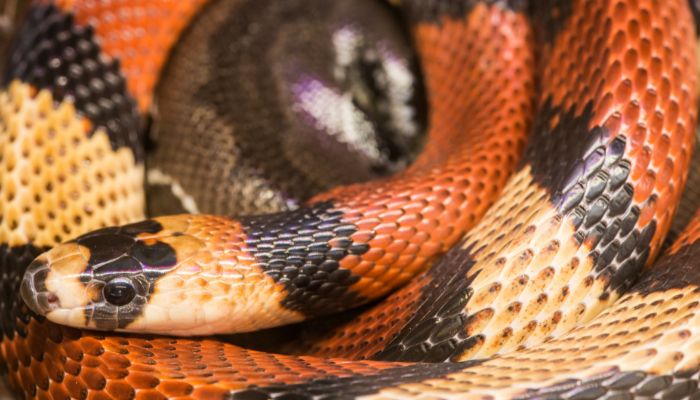
Why are Milk Snakes called Milk Snakes: The Origin
The Mystical Setting: Old American Barns
To start, the name “milk snake” paints quite the picture. Even though, as we’ve delved into, they don’t sip on milk, the origin of this mesmerizing name is wrapped in layers of lore.
Long ago, in the rustic corners of America, barns were more than mere shelters for livestock. They stood as the epicenters of farms, brimming with life and stories. Among the regular visitors to these barns were our slithering protagonists, the milk snakes.
Folktales in the Farmland
Farmers, with their knack for spinning yarns, began to weave tales upon spotting these snakes amidst their dairy cows.
The narrative? By the veil of night, while the world slept, these secretive creatures would creep up to the udders of unsuspecting cows and stealthily drink their milk.
Though it paints a vivid and somewhat cheeky picture, it’s a tale more rooted in imagination than in reality. The true allure of the barns for the milk snakes wasn’t the milk or the cows, but the plentiful supply of rodents – their primary diet.
The Legend Lives On
But as with most legends, once a story finds its audience, it flourishes. The tales passed from one generation to the next, becoming more embroidered with each telling.
Thus, the moniker “milk snake” became the popular name for Lampropeltis triangulum. It’s a title rooted in myth, but one that lends an enchanting aura to this snake.
So, armed with this knowledge, the next time the topic of milk snakes crops up in a conversation, not only can you debunk myths but also regale them with a tale as old as time.
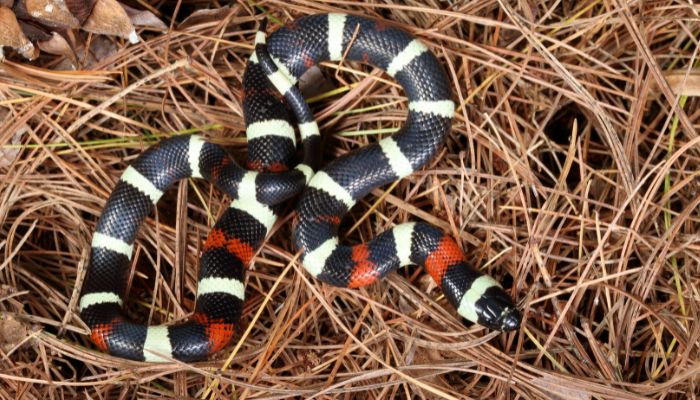
The Biological Impossibility
Their bodies are fine-tuned machines, meant for specific dietary habits. Let’s unravel the biology behind why the very idea of a milk snake drinking cow’s milk is, well, a tad far-fetched.
How Snakes Digest Food
Snakes, in their essence, are carnivorous. Their digestive systems are built to handle the meat of prey. When a snake consumes its food, the complex proteins and fats are broken down by potent digestive enzymes in their stomach.
It’s a slow and deliberate process, allowing them to go days, sometimes even weeks, between meals. Lactose, the main sugar in milk, requires a different set of enzymes for digestion. Simply put, snakes lack the biology to efficiently break down and absorb lactose.
Anatomy of a Snake’s Mouth
Dive a little deeper, right into the snake’s mouth, and you’ll find even more reasons to debunk our milky myth. Snakes have a unique oral structure.
They’re equipped with elongated jaws that can dislocate to swallow large prey, and recurved teeth that grip and hold onto their meal. Their mouth and throat are designed for swallowing whole prey, not for the suction needed to drink milk from a cow’s udder.
Why It’s Biologically Impossible
Given their dietary habits and anatomy, the act of a snake drinking milk directly from a cow is just… impossible. First, they don’t have the necessary biological tools to latch onto an udder and suck.
Moreover, even if they somehow managed this fantastical feat, the milk would not be a beneficial nutrient source due to their inability to digest lactose.
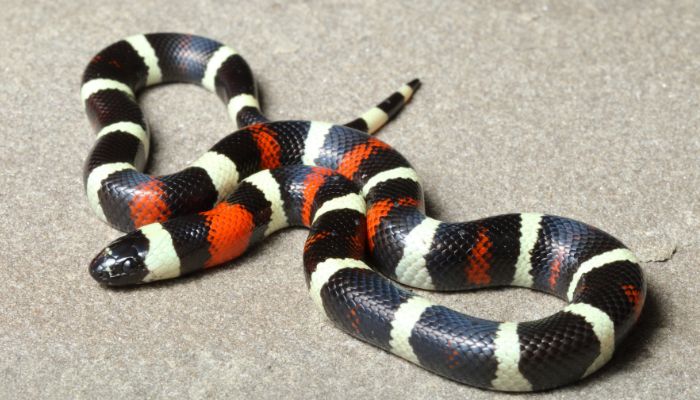
Decoding the Milk Snake’s Appearance
The world of snakes is rife with colors, patterns, and textures that can beguile even the keenest of observers. And the milk snake is no exception with its captivating appearance.
Milk Snake’s Coloration and Patterning
Milk snakes boast a striking color palette of red, black, and white or yellow bands. These colors alternate, creating a vibrant, almost rhythmic pattern along their sleek bodies.
This vibrant display isn’t just for show; it serves as a form of mimicry to ward off potential threats.
How Their Appearance Might Have Contributed to the Myth
Here’s a fun twist: the vibrant colors of the milk snake bear a strong resemblance to some venomous snake species. This mimicry might have given our harmless milk snake a formidable reputation in the eyes of early observers.
As humans, we often attach stories to things we find mysterious or fear. The milk snake’s misleading appearance could very well have been the spark that ignited tales of its supposed mystical, milk-drinking tendencies.
Comparison to Other Similarly Colored Snakes
The milk snake’s palette is reminiscent of the venomous coral snake.
The saying goes, “Red touch yellow, kills a fellow; red touch black, venom lack,” helping to differentiate the two.
The milk snake, with its non-venomous nature, falls into the latter category. This resemblance further fuels its mystique, making it both admired and misunderstood.
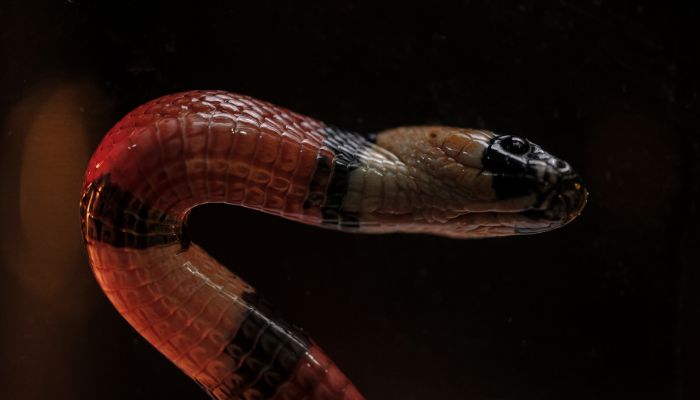
Milk Snake’s True Diet
Enough of myths and misconceptions; let’s delve into the real gastronomic preferences of the milk snake!
What Do They Truly Eat?
Milk snakes, like many of their slithery brethren, have carnivorous appetites. Forget milk; their preferred menu consists of rodents, small mammals, and sometimes even other reptiles. It’s all about the meat!
Main Diet: Rodents, Small Mammals, and Other Reptiles
Barns, often associated with milk snakes due to the myths, indeed attract them, but for entirely different reasons. Barns are often a hotspot for mice and rats, making them the perfect hunting ground.
These snakes also sometimes snack on birds, lizards, and smaller snakes, showcasing their varied palate.
Their Hunting Methods
Milk snakes are constrictors, which means they don’t rely on venom to subdue their prey. Instead, they use their strong, muscular bodies to coil around their meal, applying pressure until the prey is incapacitated.
Once their meal is subdued, they swallow it whole, making the most of their flexible jaws and adaptive digestive system.
Conclusion
You’ve journeyed through the captivating world of milk snakes, dispelling myths and uncovering truths. Now you know that these snakes don’t drink milk, and their name is steeped in folklore rather than fact.
You’ve also gained insight into their vibrant appearance and true dietary habits. Knowledge is empowering, and by understanding the world around us better, we can appreciate its wonders even more.
Keep that curiosity alive, and continue to seek the truth in all tales you encounter!
FAQ
What do milk snakes eat?
Milk snakes primarily feast on rodents, small mammals, and occasionally other reptiles. They’re constrictors, using their muscular bodies to incapacitate their prey before swallowing them whole. No milk on their menu!
Do milk snakes drink milk from cows?
Nope! This is a common myth. Milk snakes don’t drink milk from cows or any other source for that matter. Their digestive systems aren’t designed to handle milk, especially the lactose it contains.
Why are milk snakes called milk snakes?
The name originates from an old tale where these snakes were believed to drink milk straight from cows in barns. In reality, they were likely in barns hunting for rodents. The name, though based on a myth, has stuck around and become a popular moniker for this colorful reptile.



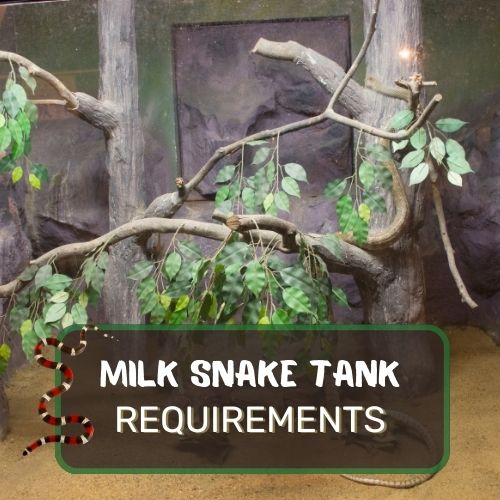
0 Comments